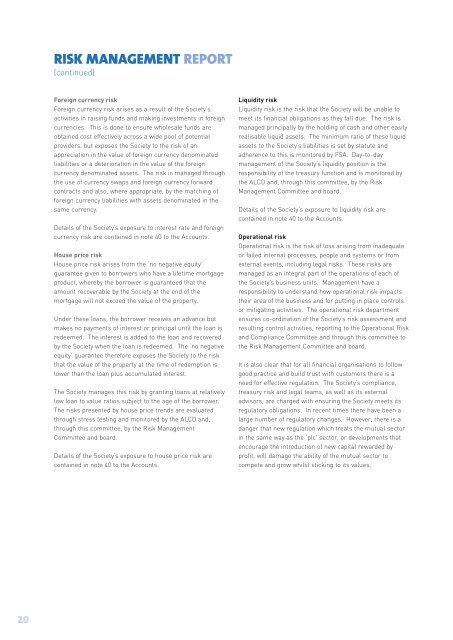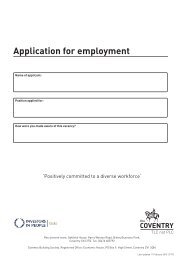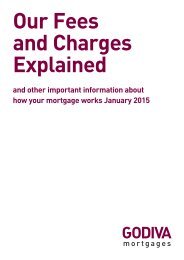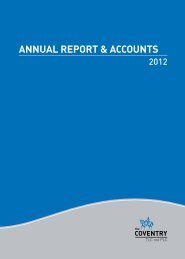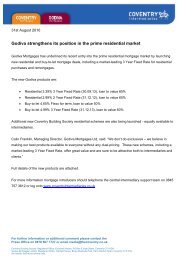Annual report and accounts 2009 (PDF) - Coventry Building Society
Annual report and accounts 2009 (PDF) - Coventry Building Society
Annual report and accounts 2009 (PDF) - Coventry Building Society
Create successful ePaper yourself
Turn your PDF publications into a flip-book with our unique Google optimized e-Paper software.
RISK MANAGEMENT REPORT(continued)Foreign currency riskForeign currency risk arises as a result of the <strong>Society</strong>’sactivities in raising funds <strong>and</strong> making investments in foreigncurrencies. This is done to ensure wholesale funds areobtained cost effectively across a wide pool of potentialproviders, but exposes the <strong>Society</strong> to the risk of anappreciation in the value of foreign currency denominatedliabilities or a deterioration in the value of the foreigncurrency denominated assets. The risk is managed throughthe use of currency swaps <strong>and</strong> foreign currency forwardcontracts <strong>and</strong> also, where appropriate, by the matching offoreign currency liabilities with assets denominated in thesame currency.Details of the <strong>Society</strong>’s exposure to interest rate <strong>and</strong> foreigncurrency risk are contained in note 40 to the Accounts.House price riskHouse price risk arises from the ‘no negative equity’guarantee given to borrowers who have a lifetime mortgageproduct, whereby the borrower is guaranteed that theamount recoverable by the <strong>Society</strong> at the end of themortgage will not exceed the value of the property.Under these loans, the borrower receives an advance butmakes no payments of interest or principal until the loan isredeemed. The interest is added to the loan <strong>and</strong> recoveredby the <strong>Society</strong> when the loan is redeemed. The ‘no negativeequity’ guarantee therefore exposes the <strong>Society</strong> to the riskthat the value of the property at the time of redemption islower than the loan plus accumulated interest.The <strong>Society</strong> manages this risk by granting loans at relativelylow loan to value ratios subject to the age of the borrower.The risks presented by house price trends are evaluatedthrough stress testing <strong>and</strong> monitored by the ALCO <strong>and</strong>,through this committee, by the Risk ManagementCommittee <strong>and</strong> board.Details of the <strong>Society</strong>’s exposure to house price risk arecontained in note 40 to the Accounts.Liquidity riskLiquidity risk is the risk that the <strong>Society</strong> will be unable tomeet its financial obligations as they fall due. The risk ismanaged principally by the holding of cash <strong>and</strong> other easilyrealisable liquid assets. The minimum ratio of these liquidassets to the <strong>Society</strong>’s liabilities is set by statute <strong>and</strong>adherence to this is monitored by FSA. Day-to-daymanagement of the <strong>Society</strong>’s liquidity position is theresponsibility of the treasury function <strong>and</strong> is monitored bythe ALCO <strong>and</strong>, through this committee, by the RiskManagement Committee <strong>and</strong> board.Details of the <strong>Society</strong>’s exposure to liquidity risk arecontained in note 40 to the Accounts.Operational riskOperational risk is the risk of loss arising from inadequateor failed internal processes, people <strong>and</strong> systems or fromexternal events, including legal risks. These risks aremanaged as an integral part of the operations of each ofthe <strong>Society</strong>’s business units. Management have aresponsibility to underst<strong>and</strong> how operational risk impactstheir area of the business <strong>and</strong> for putting in place controlsor mitigating activities. The operational risk departmentensures co-ordination of the <strong>Society</strong>’s risk assessment <strong>and</strong>resulting control activities, <strong>report</strong>ing to the Operational Risk<strong>and</strong> Compliance Committee <strong>and</strong> through this committee tothe Risk Management Committee <strong>and</strong> board.It is also clear that for all financial organisations to followgood practice <strong>and</strong> build trust with customers there is aneed for effective regulation. The <strong>Society</strong>’s compliance,treasury risk <strong>and</strong> legal teams, as well as its externaladvisors, are charged with ensuring the <strong>Society</strong> meets itsregulatory obligations. In recent times there have been alarge number of regulatory changes. However, there is adanger that new regulation which treats the mutual sectorin the same way as the ‘plc’ sector, or developments thatencourage the introduction of new capital rewarded byprofit, will damage the ability of the mutual sector tocompete <strong>and</strong> grow whilst sticking to its values.20


